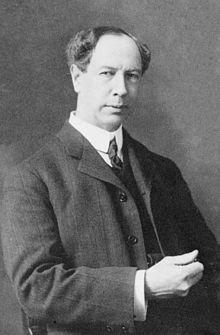Thomas Willson
Thomas Leopold Willson (born March 14, 1860 at Princeton (Ontario) , † December 20, 1915 in New York City ) was a Canadian inventor and entrepreneur. He is known for inventing a manufacturing process for calcium carbide (starting product of the acetylene industry) in an electric furnace he developed. The French chemist Henri Moissan succeeded in producing calcium carbide around the same time, independently of Willson .
Willson went to school in Hamilton, Ontario , and became interested in and experimented with electricity while working for a blacksmith. He was unable to sell his electrical lighting system with a dynamo he had developed in Canada and moved to New York in 1881 to market his invention in the USA. There he worked as an inspector for electrical companies and continued to work on his inventions, especially in the use of electricity in the reduction of metals, for example in aluminum production. With the investor James Turner Morehead , who supplied electricity with his water mills (used for cotton spinning), he founded the Willson Aluminum Company in 1891. He also experimented with calcium to reduce aluminum chloride in his electric furnace and found calcium carbide when he heated limestone with powdered anthracite in the furnace. When water is added to the calcium carbide, the flammable acetylene gas that can be used in lamps is formed. Willson then developed an inexpensive industrial method for producing calcium carbide. The acetylene of Carbidlampe was town gas superior in brilliance (and the early electric light bulbs), around 1903 came the use added as a welding gas. Willson was nicknamed Carbide because of the discovery .
In the company he had with Morehead, they also developed ferrochrome . He sold the patent in 1895 to what would later become Union Carbide (founded in 1898 by John Motley Morehead III , the son of James Turner Morehead) and moved back to Canada himself. Before that, he married in California in 1895. He built calcium carbide factories in Ontario, Ottawa and Quebec, and in 1906 he started a light buoys and lighthouse lamp company. He became very prosperous (first owner of a car in Ottawa). He pursued other visionary projects with his own process for nitrogen production for fertilizer, hydropower projects and investments in the wood and paper industry. To do this, he sold his calcium carbide patents and companies in Canada and looked for investors in New York. When he defaulted on an interest rate on the New York tobacco and textile millionaire James Buchanan Duke , Willson's investments and assets were seized upon him. Willson did not give up and, after discovering that he still had calcium carbide rights to Labrador and Newfoundland, again sought investors in New York. There he died of a heart attack in 1915. He is buried in Ottawa .
Web links
- Dictionary of Canadian Biography (English)
| personal data | |
|---|---|
| SURNAME | Willson, Thomas |
| ALTERNATIVE NAMES | Willson, Thomas Leopold (full name) |
| BRIEF DESCRIPTION | Canadian inventor and entrepreneur |
| DATE OF BIRTH | March 14, 1860 |
| PLACE OF BIRTH | Princeton (Ontario) |
| DATE OF DEATH | December 20, 1915 |
| Place of death | New York City |
